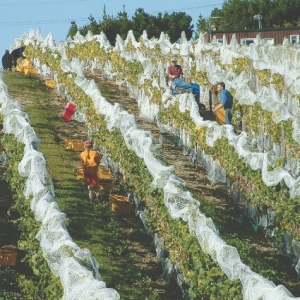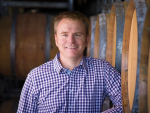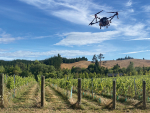When he talks about the region’s wine styles he says; “Nelson’s wine identity has not been aided by the fact it does not have a dominant wine style along the lines of Marlborough Sauvignon Blanc or Central Otago Pinot Noir. A versatile region, it is succeeding with several varieties, Sauvignon Blanc from the Waimea Plains can be distinctly Marlborough-like, and Riesling and Chardonnay perform strongly throughout the region. Some highly aromatic, richly flavoured Gewurztraminers and Pinot Gris are also produced, and Pinot Noir is yielding superb wines at Upper Moutere and on the edge of the plains in heavier clay-based soils at the base of the hills.”
Located at the top of New Zealand’s South Island and surrounded by mountains to the east, west and south, and Tasman Bay to the north the Nelson region enjoys a region-wide sheltered horticulture climate with an average 2700 sunshine hours per annum. While other regions occasionally have slightly higher annual sunshine hours, Nelson is considered the sunshine capital of New Zealand.
The region’s clear, cool nights allow all fruit grown in the region to develop full flavour intensity as they ripen slowly. This is particularly important with grapes as this diurnal temperature change allows the fruit to develop distinct varietal flavours while retaining the ripe fruit acidity that provides structure and balance to the wines.
Historically the region has been one of the two major pip fruit producing regions in the country and that industry sat side-by-side a vibrant berryfruit industry, New Zealand’s only hop growing industry, a sound sheep, beef and dairying industry and for many years a tobacco industry.
With the high sunshine hours, moderate annual rainfall that is generally concentrated in the winter months, diverse geographical features and a temperate maritime climate, the region has the natural versatility to do many things well and that versatility is reflected in its wine production industry.
Wine grapes have been grown in the Nelson region since about 1868 when FHM Ellis & Sons produced wine from grapes and other fruits in Golden Bay for about 70 years. In 1872 Government Viticulturist Romeo Bragato said Nelson is; “Admirably suited to cultivation of vines and trees” and he “has no hesitation in advising residents to plant vines on a large scale”.
While wine has been made on a small scale continuously since then and the modern wine era was established in a small way by Viggio du Fresne in 1967, it wasn’t until Hermann and Agnes Seifried established Seifried Estate in Upper Moutere in 1974 that the scene was set for the vibrant wine industry we see today.
As the pip fruit industry faced significant challenges in the world market in the mid 1990’s the Bolitho family were one of a number to convert their apple orchards on the Waimea Plains to grape vines and they established one of two major vineyard plantings, along with Seifried Estate who had expanded significantly onto the fertile alluvial soils of the Waimea Plains.
Of course many other winegrowing businesses were established during this period and since, some of significant volume, many of significantly high quality and some that produce industry leading wines.
The Sub-regions
The Nelson winegrowing region is split into two key geographic areas, the Waimea Plains and the Moutere Hills, with an emerging area, coastal Tasman, and another that produces tiny amounts of wine in particularly challenging terrain, Golden Bay. While rainfall, sunshine hours and growing degree days are very consistent across the region, soil types vary significantly between the plains and the hills.
The Moutere Hills run in a south-west to north-east line reaching to the coast from the protecting southern hill ranges, while the ancient river bed soils of the Waimea Plains are wedged between these hills and the Richmond Ranges to the east.
There is a strong argument for further defining specific areas within these sub-regions as the soil structure varies significantly in different parts of both the generic Moutere Hills and Waimea Plains sub-regions.
The Moutere Hills
Inland Moutere Hills and coastal Moutere Hills share many of the same geographic features but the closer you get to the coast the more free-draining the clay soils become, with sandy loam soils over deep ancient stony clay soils, rather than the slightly heavier loam soils over stony clay on the more inland vineyards.
Closer to the coast both moisture and cool air drain down the slopes to the coastline reducing the risk of spring frosts to almost nil and certainly minimal. The gentle afternoon sea breeze also eases the temperature spikes in the heat of summer and quickly dries vineyards after any summer rainfalls reducing disease risks.
While inland Moutere Hills vineyards may not enjoy the same climatic benefits of coastal vineyards they do have the benefit of a more elevated and sheltered environment. This elevation gives these sites the benefit of slightly higher degree growing days with cooler air draining down the valleys creating just enough air movement to protect well located vineyards from late spring frosts.
Slightly heavier soils result in rich, textural and highly flavoured wines that have a distinct mineral backbone as proved beyond doubt by the Neudorf Vineyards site that delivers powerful world class wines. Ask Judy Finn what makes their wines so good and she has a two word answer - ‘The soil’. She says even with the huge effort they put into viticulture and winemaking, without their unique soil structure the wines they make simply wouldn’t have the same characteristics.
Varieties that perform particularly well in the Moutere Hills environment include Chardonnay, Pinot Noir, Pinot Gris and Riesling. More recent plantings of Albarino and Gruner Veltiner are delivering promising early results while little micro-climates successfully ripen Syrah and Montepulciano.
The Plains
In general terms the vineyards of the Waimea Plains enjoy free draining silty or sandy soils covering deep river gravels. Closer to the foothills however you will find a layer of slightly heavier clay soils that have washed down from the hills over many centuries above the deep river gravels.
As an example Seifried Estate has vineyards in several areas of the wider plains district and have planted varieties best suited to the soil types. The Rabbit Island vineyards consists of “a silty, sandy surface with a very gravelly sub-surface making the ground free draining, friable and easily worked” and because the nearby Appleby River flows to the coast not far from their vineyards the water table is high and there is no need for irrigation.
Seifrieds Brightwater vineyard 15km inland from the coast sits on soils that range from large gravelly areas to light sandy loam soils, which result in a very porous soil structure that requires some irrigation in the summer months. These two vineyards sit at either end of the Waimea Plains and the area between the two is primarily friable and free-draining soils, often with a very thin layer of soil over the ancient, deep river gravels.
This mid-plains area is dominated by Waimea Estates but is also home to a number of mid-sized and more boutique producers.
The soil structures are particularly well suited to the varieties Sauvignon Blanc, Riesling, Pinot Gris and Chardonnay while vineyards like Greenhough have the benefit of a layer of clay soils on the foothills at the edge of the plains to add depth and texture to their Pinot Noir. As with the Moutere Hills Albarino and Gruner Veltliner are delivering promising early results.
Because this is a near coastal environment there is almost always a gentle breeze flowing down the plains from the protective mountains in the south to Tasman Bay just as the river that created the plains has done for many centuries.
I will leave the last words to Garry Neale from Brightwater Vineyards who says “We are not a slice of Tuscany or Provence. We are Nelson, New Zealand, and proud of it, Nelson is a fantastic place to live and make wine, and the rest of the world is starting to realise it”. ν
This email address is being protected from spambots. You need JavaScript enabled to view it.














